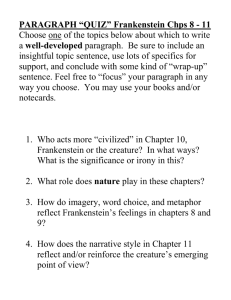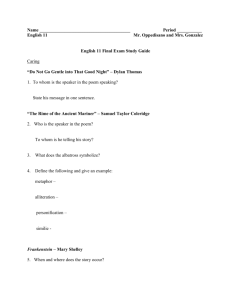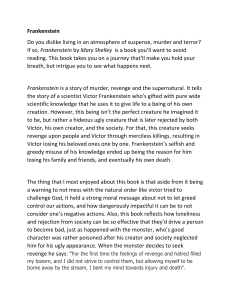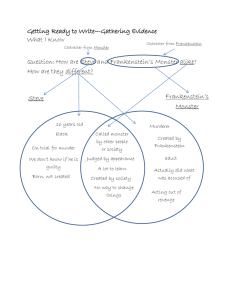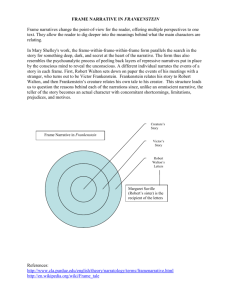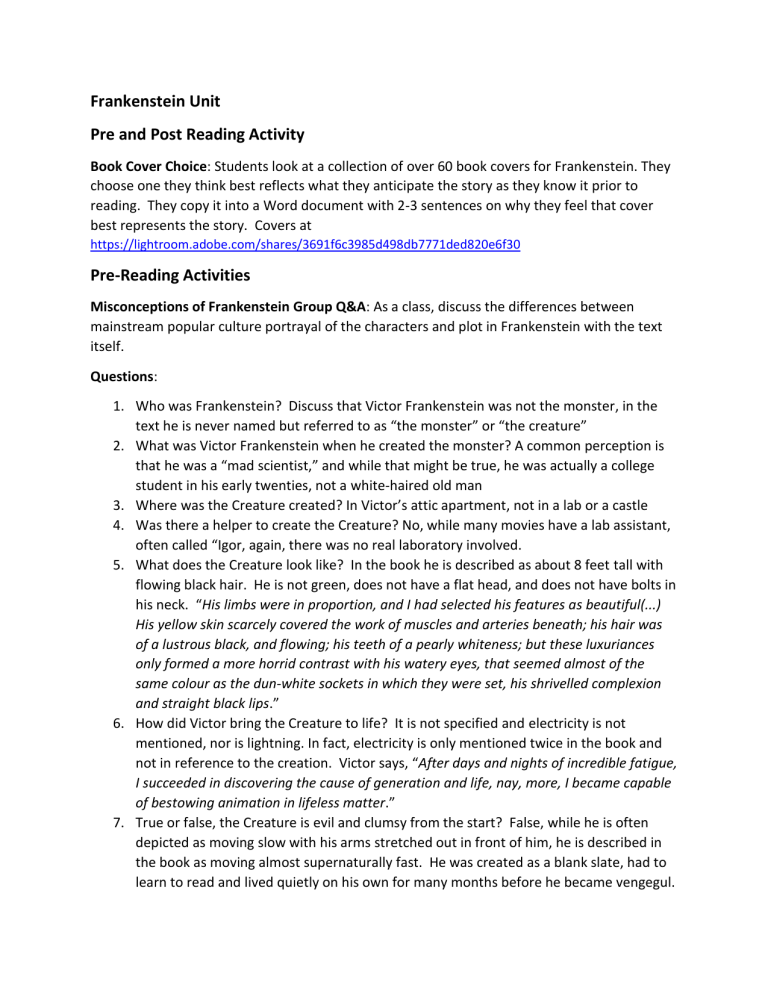
Frankenstein Unit Pre and Post Reading Activity Book Cover Choice: Students look at a collection of over 60 book covers for Frankenstein. They choose one they think best reflects what they anticipate the story as they know it prior to reading. They copy it into a Word document with 2-3 sentences on why they feel that cover best represents the story. Covers at https://lightroom.adobe.com/shares/3691f6c3985d498db7771ded820e6f30 Pre-Reading Activities Misconceptions of Frankenstein Group Q&A: As a class, discuss the differences between mainstream popular culture portrayal of the characters and plot in Frankenstein with the text itself. Questions: 1. Who was Frankenstein? Discuss that Victor Frankenstein was not the monster, in the text he is never named but referred to as “the monster” or “the creature” 2. What was Victor Frankenstein when he created the monster? A common perception is that he was a “mad scientist,” and while that might be true, he was actually a college student in his early twenties, not a white-haired old man 3. Where was the Creature created? In Victor’s attic apartment, not in a lab or a castle 4. Was there a helper to create the Creature? No, while many movies have a lab assistant, often called “Igor, again, there was no real laboratory involved. 5. What does the Creature look like? In the book he is described as about 8 feet tall with flowing black hair. He is not green, does not have a flat head, and does not have bolts in his neck. “His limbs were in proportion, and I had selected his features as beautiful(...) His yellow skin scarcely covered the work of muscles and arteries beneath; his hair was of a lustrous black, and flowing; his teeth of a pearly whiteness; but these luxuriances only formed a more horrid contrast with his watery eyes, that seemed almost of the same colour as the dun-white sockets in which they were set, his shrivelled complexion and straight black lips.” 6. How did Victor bring the Creature to life? It is not specified and electricity is not mentioned, nor is lightning. In fact, electricity is only mentioned twice in the book and not in reference to the creation. Victor says, “After days and nights of incredible fatigue, I succeeded in discovering the cause of generation and life, nay, more, I became capable of bestowing animation in lifeless matter.” 7. True or false, the Creature is evil and clumsy from the start? False, while he is often depicted as moving slow with his arms stretched out in front of him, he is described in the book as moving almost supernaturally fast. He was created as a blank slate, had to learn to read and lived quietly on his own for many months before he became vengegul. 8. The monster is evil because he was given the brain of a criminal. This is not mentioned anywhere in the text, in fact, the text does not support that Victor obtained parts of the creature from graves. Instead, he haunted “the dissecting room and the slaughter house” to collect his “materials.” Pre-reading Follow Up Activity Students independently watch two Crash Course videos on Frankenstein imported into Vizia and answer questions embedded in them. https://vizia.co/videos/25957495f576342206abfe/share https://vizia.co/videos/8ec023b8609cb065416e68/share Assessment: Results of answers exported to Excel. Review responses with students. Reading Activities Prior to each chapter students play Frankenstein Vocabulary with Kahoot as a group to introduce upcoming challenging vocabulary. Slides include a quote from the text using the word. https://create.kahoot.it/share/vocabulary-from-frankenstein/e1cfd950-6719-4a22-b9d87536967725d1 Chapter Review Fake Text Messages Groups are assigned to review plot and character activity from recently read chapters and to describe using modern day language via text using https://ifaketextmessage.com/ Images of the text message are saved to a shared location (network drive, OneDrive, Office 365) and shared with the class, who may choose to vote on their favorite one. Extension: winning texts are put in order on website or as pdf booklet and shared online. Culminating Activities Mapping the Monster: Students access a teacher created Google My Maps and are assigned a geographical location mentioned in the book. They research the location and use the online ebook https://www.gutenberg.org/files/42324/42324-h/42324-h.htm find out why that places is significant, what characters were involved and a brief description of plot at that point. They locate the area on the Google map, add to the map, edit to provide background information and upload a photo of the location. At the end, measure the number of miles traveled by Victor and the creature. Book Cover Post-Reading Reflection: Students revisit the book cover they choose before reading the book as well as the gallery. They reflect on whether it still best represents their idea of the story and explain whether it does or does not still best represent the story as they know it. If it does not they choose another cover and explain how it is more representative and why. Supporting Materials Mary Shelley’s Frankenstein in Charts LAB-GROWN MINI-BRAINS COULD OUTSMART US IN THE FUTURE IF WE'RE NOT CAREFUL | OPINION: NEWSWEEK

